Penguins are birds that live in the regions of the southern hemisphere. Most people think of penguins as “modern birds.” Found in temperatures ranging from 45 to 60 degrees.
A common myth is that all penguins live inland Antarctica, but penguins breed on islands, and not all penguins dwell in Antarctica. Some reside in temperate climates, while others live near the equator.
Penguins can survive in sub-freezing temperatures. They can survive without food for weeks, hold their breath for about 15 minutes, and dive over 1600 feet deep. The lifespan of penguins varies among the species. Most penguins live on an average of about 15 to 20 years.
Today, we are going to dive deep and understand – " Do Penguins Eat Crabs?" Are you ready? Let’s go!
Who Are The Penguins?
Penguins are often known for their stocky, short-legged appearances. These incredible birds range from 35 cm to 115 cm in height and 1 kg to 40 kgs in weight.
The Penguin’s body intended to make swimming in the water a breeze. Therefore, it is more at home in the water than on land or in the air. It has a fusiform body.
What is a fusiform body? Fusiform means having a spindle-like shape wide in the middle and tapers at both ends. It is lemon-shaped but often implies a focal broadening of a structure.
Penguins have a large head, a lengthy torso, and stiff, short tails that identify this lovely creature. On land, their web-footed legs assist them in maintaining an erect position.
Many species come in a variety of hues and patterns. Most penguins are black overall, with the stomach being white, black lines on the upper breast, and a white mark on the head.
Some species have light yellow or red irises of eyes, while others have red beaks. There are also penguins with orange and yellow spots on the head, neck, and breast.
In general, penguins are not sexually dimorphic. Thus, both males and females look alike.
Crested and royal penguins are the exceptions in which you can visually identify males from females.
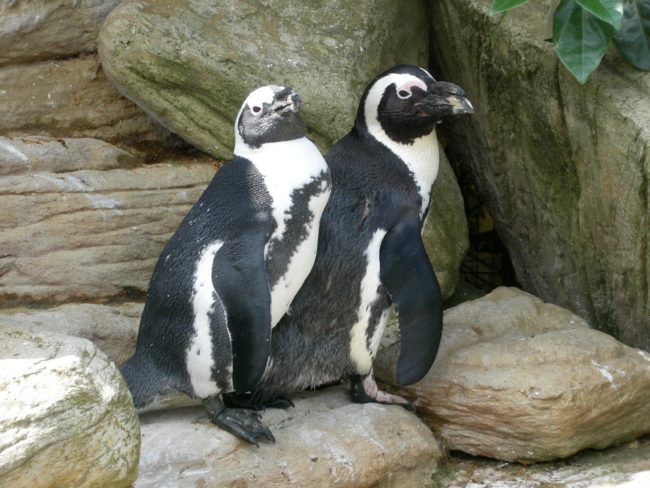
Male vs. Female penguin difference
In crested penguins, males are more robust than females. While in emperor penguins, Males have white cheeks, whereas females have gray-colored cheeks.
Penguins modified their wings to flippers. The flippers on each side, covered in little feathers, allow the birds to swim more quickly in the water. They are used to propel themselves across the water.
Do All Different Penguins Species Have Same Characteristics?
According to the Antarctica government, there are 18 species of penguins on the globe. However, this number varies from 17 to 20, depending on the source. Varied penguin species may be of different colors, different sizes, and even different breeding patterns.
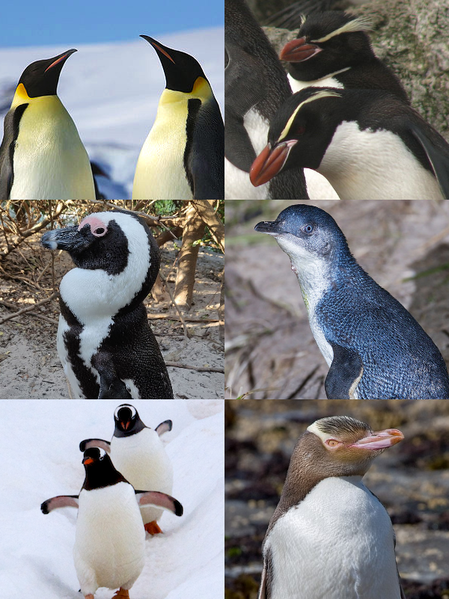
Varied penguin species
Adelie penguins are about 17cm tall and 5kg in weight. These are the second most breeding penguin species in the Antarctic and Sub-Antarctic regions. The breeding season of penguins is from November to February. The estimated population of this species is about 2.5 million.
Chinstrap penguins are another species of penguins found in the Sub-Antarctic Islands. It is about 68 cm in height and 4.5 kg in weight. The breeding season is from December to March, with nearly 5 million.
Emperor Penguins, with a height of 1.5 meters and 30 kilograms, are among the most frequent penguin species in Antarctica. These penguins breed from April to December.
The Falkland Islands and the Sub-Antarctic Islands are home to Gentoo Penguins. With a height of about 95 cm and roughly 15 kg.
King penguins have their largest colony in South Georgia. It has a complex breeding system that starts in November and ends in January.
Macaroni Penguins are 68 cm in height and 4.5 kilograms in weight, with a breeding season from December to March.
Another type of Penguin - the Rockhopper penguin, has a height of 55 cm and weight of 2.5 kg and has a breeding season from December to March.
Do All Penguin Species Eat Crab?
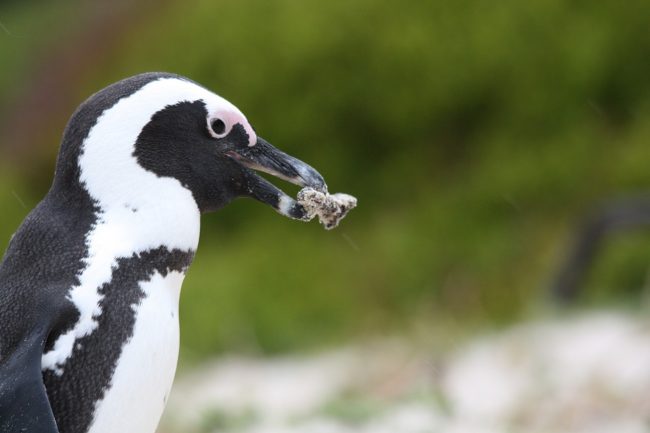
Penguins eating crab
Penguins are incredible eaters with a restricted diet. A better understanding of what penguins eat gives us an idea to protect and conserve their foods. It also provides the penguins a rehabilitator to successfully meet the dietary needs of these unique birds.
Penguins have a piscivorous diet by getting everything from the sea for the various seasons. The exact food habit of penguins depends on their range, foraging behavior, bill size and shape, and all other factors.
Penguins are carnivorous and consume a seafood diet. Their diving abilities allow them to obtain seafood from the entire ocean. Let’s see what they eat. Can we start?
- Krill - Krill are tiny creatures found throughout the ocean. It measures roughly 2 inches in length. Krill can be seen from space as they swarm in large numbers.
The life of most of the creatures in the Antarctic Ocean depends on the krill. Hundreds of life forms such as Macaroni, Adelie, and Chinstrap penguins depend on krill as a dietary staple.
- Fish - Penguins consume small fish in the ocean. The diet of Chinstrap and Emperor penguins is fish.
They catch and eat the fish with their powerful beaks and barbs of their tongues. They consume fish like Sardine, Smelt, Herring, and Anchovies.
- Squid - Emperor, Gentoo, and Rockhopper penguins eat squid, which is available in specific seasons.
Cephalopods have a vast brain, eight limbs, and two hearts. Squid are cephalopods. Squid are abundant in the summer, so penguins consume more of them. They use arrows and hooks to eat immature and tiny squid.
- Crustaceans - Penguins sometimes eat crustaceans invertebrates with exoskeletons and segmented bodies.
Crustaceans include shrimp, crabs, and sand hoppers. Adult penguins can dive up to 300 feet to consume small crustaceans, and mainly penguins obtain the crabs at 150 to 165 feet.
- Amphipods - Chinstrap penguins consume Amphipods that look like shrimps. Unlike crustaceans, Amphipods do not have hard covering near the thorax.
These are available undersea and have become a staple food for many penguins, fish, seals, and birds. You can see these tiny creatures in all aquatic habitats.
The diet of penguins varies slightly based on the species of the penguins that have different diet preferences. The type of food varies with the geographical condition of that region and the time of year.
In Antarctic and Sub-Antarctic areas, where the small fish are uncommon, penguins have adapted to eat crustaceans like crabs.
Crabs are the primary food source for tiny penguins like Adelie and Chinstrap. African penguins are generalists, and they can consume crustaceans, but it is not their sustainable diet.
For Instance - North Rockhoppers prefer crabs as a staple diet. The giant penguins like Emperor and King Penguins prefer fishes and crabs as the main course in their menu.
The total amount of food consumed by a large penguin colony is immense and often exceeds several tons per day.
How Much Does A Penguin Eat?
The remarkable swimming abilities and keen underwater sight give a hunting advantage to the penguins.
The hunting tactics vary from species to species, and they obtain the prey through deep and shallow dives. These techniques of hunting prey depend on the ocean currents, weather pattern change, and other mitigating changes.
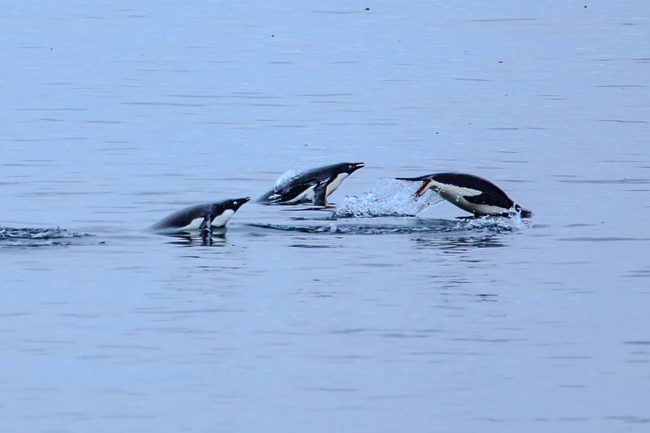
Penguins hunting for their food
The distance traveled by the penguins for hunting also varies between the species.
For Instance, the emperor penguins travel about 300 to 500 miles from their nesting area to hunt for several weeks.
In other cases, Galapagos penguins do not even move a mile from their nest to obtain the prey.
Some penguins forage in small groups, while the others with yellow eyes prefer solo ventures.
The penguins mainly depend on high insulated feathers for protection, and they remain idle on fasting during molting. They usually lose 25 to 30 pounds of body weight during molting.
During molting, penguins cannot enter the ocean to seek prey, and nesting penguins also fluctuate in importance during foraging.
The fasting period of molting can last for about several weeks, followed by some long foraging trips during which the birds will regain their lost weight. When penguins forage for prey like small fish, they swallow them entirely.
They have a two-chambered stomach. With the prey entering one chamber. The other chamber stores food for the chicks.
Most digestion occurs in the stomach’s thick wall, grinding the more complex particles.
What Type Of Crabs Are Preferred By Penguins?
One of the most enjoyable diets of penguins is crustaceans, including crabs, krill, lobster, and more.
There are about 4,400 varieties of edible crabs to these penguins. The most common types are blue crabs, Dungeness crabs, horseshoe crabs, king crabs, peaky toe crabs, rock crabs, and stone crabs.
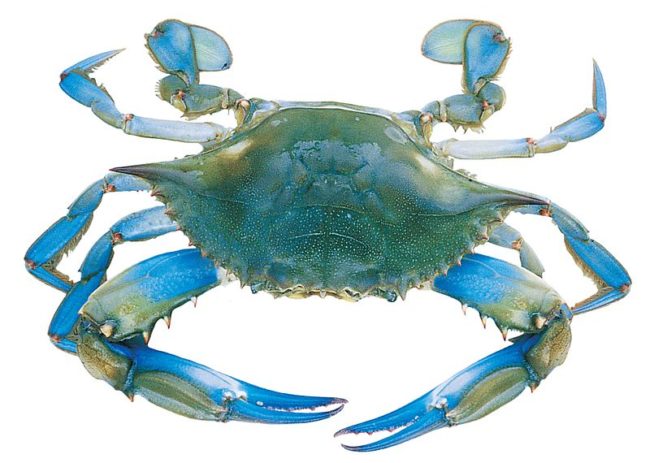
Blue Crab
King penguins prefer a small number of crustaceans and 30% fish in winter and 80% in summer.
Penguins tend to form colonies near productive waters to seek crabs. Smaller penguins may eat many horseshoe crabs.
How Do Penguins Eat Crabs?
Found along the coast of the Western Hemisphere, the blue crabs. Penguins often eat older blue crabs by stabbing crabs and crunching up its shells with their large beaks before swallowing them wholly. Used to digest them are stones.
Penguins in the Arctic regions consume horseshoe crabs. Each Penguin can eat thousands of horseshoe crab eggs each day.
A common phenomenon seen in Penguins is that they don’t chew food, but they eat and swallow rocks which in turn help them to consume their food. It sounds bizarre, but it’s true.
Why do different penguins eat different sizes? Giant penguins eat bigger prey because they need more nourishment for their bodies to defend themselves from other penguins. Penguins eat pebbles of various sizes for this very reason.
The pebbles help break down the various parts of a fish or squid or any other type of food. Though small, a penguin’s stomach can quickly digest any form of food.
This method of digestion isn’t unique to penguins. Other birds such as chickens, ostriches, and even crows swallow pebbles to aid digestion.
For Instance: A parakeet is one more type of bird; you can put something called grit into its cage. This grit does the same purpose for a parakeet that a pebble does for penguins. A parakeet eats the grit to quickly break down the seed the little bird eats every day.
The pebbles move around the Penguin’s beak, and the sharp beak helps to break down a penguin’s food in its digestive system.
The pebbles take on a smooth surface in their system with these movements. Smaller rocks eventually dissolve with this activity. However, larger stones may move through a penguin’s digestive system and leave the bird’s body when it poops.
In addition, some scientists have found pebbles in the stomachs of dead penguins.
How Do Penguins Hunt Crabs?
Captive penguins do not undergo long fasting periods during molting. Instead, the rehabilitator, biologist, veterinarians, and zookeepers control penguins’ diet.
These caretakers provide whole or chopped fish and crabs to the captured wild penguins. Other supplements - could be added to penguins’ diets in captivity.
Penguins in the wild often depend on oceanic habitats rather than ponds. The ocean is less polluted, and clear water preserves the Penguin’s prey.
Many penguin species such as king and emperor penguins hunt the crabs in aquatic environments, which live in the surface water or mid-level depth of several hundred to thousand feet.
Some other penguins, such as Emperor, King, Gentoo, Rock hopers, and yellow-eyed penguins, will hunt in the benthic environment in coastal regions around their colonies.
Penguins often prefer the most nutritious food with the least possible effort. Penguins opportunistically hunt their prey.
For Instance, the tiny penguins in the coastal regions of Australia catch jellyfish after many unsuccessful hunts of the preferred crabs.
The little banded penguins often group forage to seek their crustaceans’ prey. Group hunting may also be an anti-predator behavior.
Penguins hunting together may compete with one another for prey. Found that Gentoo penguins try to catch another’s catch at least occasionally actively.
Group of African penguins normally bunch schools of crab, allowing individual penguins to sweep through and snack the caught crabs or grab them before escaping from the tight-packed cluster.
The black and white patterns of penguins are an adaptation that confuses the crustaceans.
The little penguins often grab their prey from above or from the side. The more giant penguins often catch the crabs from below.
For Instance, the emperor fish descends to the deepest depths and rises to trap the crab against the seabed.
The tendency to grab from below involves simply greater visibility from the orientation. Found that the Gentoo penguins in the Falklands hunt the crab engaged in active defense with the pincers.
Attacking from below might be a way to trap the crabs before it has the chance to fight back. Large schools of pelagic prey like crabs often attract the penguins to find their prey within these gatherings.
These schools of prey become eye-catching from the coastal regions, which induce the penguins to catch them for diet.
Final Thoughts
Penguins are flightless birds that dwell on both land and sea. Penguins have a particular talent for swimming. The wings turn to a flipper and make them an excellent swimmer through deep waters.
Penguins have an open seafood diet which includes crustaceans such as crabs and other animals like the fish. Penguins often eat more carbs in summer, which is only one-third of the feed of penguins in winter.
The facts to get cleared with answers are indeed interesting. I hope you got the response to the factual discussion that happened one day with your friends or family where you left the space filled with sheepish smiles.
Image Sources
Male vs. Female penguin difference by suliz / Pixabay License
Varied penguin species by PaleoMatt / CC BY
Penguins eating crab by leonie_josseck / Pixabay License
Penguins hunting for their food by Murray Foubister / CC BY
Blue Crab by Virginia State Parks / CC BY
References
https://a-z-animals.com/blog/what-do-penguins-eat/
https://www.americanoceans.org/facts/what-do-penguins-eat/
https://www.coolantarctica.com/Antarctica%20fact%20file/wildlife/antarctic-penguins.php
https://www.thespruce.com/what-do-penguins-eat-386597
https://oceanwide-expeditions.com/blog/7-facts-about-antarctica-s-beloved-bird-the-penguins
https://www.britannica.com/animal/penguin/Form-and-function
https://blogs.scientificamerican.com/guest-blog/5-things-you-never-knew-about-penguins/
https://animals.mom.com/predators-crustaceans-1228.html
https://www.penguins-world.com/what-do-penguins-eat/
https://rangerplanet.com/what-do-penguins-eat-complete-list/
https://www.britannica.com/animal/penguin/Natural-history#ref48928